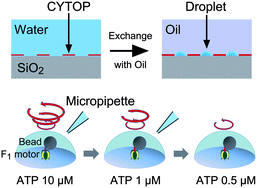A single-molecule enzymatic assay in a directly accessible femtoliter droplet array†
Abstract
The

- This article is part of the themed collection: 10th Anniversary Issue: Japan
* Corresponding authors
a
Institute of Scientific and Industrial Research, Osaka University, Mihogaoka, 8-1, Ibaraki, Osaka, Japan
E-mail:
iino@sanken.osaka-u.ac.jp, hnoji@sanken.osaka-u.ac.jp
Fax: +81-6875-5724
Tel: +81-6879-8481
b CREST, Japan Science and Technology Agency, Sanbancho 5, Chiyoda-ku, Tokyo 102-0075, Japan
c Department of Applied Chemistry, Graduate School of Engineering, The University of Tokyo, Hongo 7-3-1, Bunkyo-ku, Tokyo 113-8656, Japan
The

 Please wait while we load your content...
Something went wrong. Try again?
Please wait while we load your content...
Something went wrong. Try again?
S. Sakakihara, S. Araki, R. Iino and H. Noji, Lab Chip, 2010, 10, 3355 DOI: 10.1039/C0LC00062K
To request permission to reproduce material from this article, please go to the Copyright Clearance Center request page.
If you are an author contributing to an RSC publication, you do not need to request permission provided correct acknowledgement is given.
If you are the author of this article, you do not need to request permission to reproduce figures and diagrams provided correct acknowledgement is given. If you want to reproduce the whole article in a third-party publication (excluding your thesis/dissertation for which permission is not required) please go to the Copyright Clearance Center request page.
Read more about how to correctly acknowledge RSC content.
 Fetching data from CrossRef.
Fetching data from CrossRef.
This may take some time to load.
Loading related content
